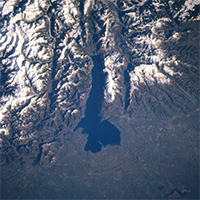Using remote sensing and numerical modelling to quantify a turbidity discharge event in Lake Garda

Submitted: 3 August 2020
Accepted: 23 September 2020
Published: 1 October 2020
Accepted: 23 September 2020
Abstract Views: 2332
PDF: 735
HTML: 44
HTML: 44
Publisher's note
All claims expressed in this article are solely those of the authors and do not necessarily represent those of their affiliated organizations, or those of the publisher, the editors and the reviewers. Any product that may be evaluated in this article or claim that may be made by its manufacturer is not guaranteed or endorsed by the publisher.
All claims expressed in this article are solely those of the authors and do not necessarily represent those of their affiliated organizations, or those of the publisher, the editors and the reviewers. Any product that may be evaluated in this article or claim that may be made by its manufacturer is not guaranteed or endorsed by the publisher.
Similar Articles
- Muhammed Shikhani, Chenxi Mi, Artur Gevorgyan, Gor Gevorgyan, Amalya Misakyan, Levon Azizyan, Klemens Barfus, Martin Schulze, Tom Shatwell, Karsten Rinke, Simulating thermal dynamics of the largest lake in the Caucasus region: The mountain Lake Sevan , Journal of Limnology: Vol. 81 No. s1 (2022): Lake Sevan. Past, present, and future state of a unique alpine lake
- Luigi Hinegk, Luca Adami, Sebastiano Piccolroaz, Marina Amadori, Marcello Moretti, Marco Tubino, Marco Toffolon, Multidecadal analysis of Lake Garda water balance , Journal of Limnology: Vol. 82 (2023)
- Xiangyu Mu, James Brower, Donald I. Siegel, Anthony J. Fiorentino II, Shuqing An, Ying Cai, Delin Xu, Hao Jiang, Using integrated multivariate statistics to assess the hydrochemistry of surface water quality, Lake Taihu basin, China , Journal of Limnology: Vol. 74 No. 2 (2015)
- Claudia Dresti, Andrea Fenocchi, Diego Copetti, Modelling physical and ecological processes in medium-to-large deep European perialpine lakes: a review , Journal of Limnology: Vol. 80 No. 3 (2021): Celebratory Issue - 80th Anniversary of the Journal of Limnology
- Franco Tassi, Dmitri Rouwet, An overview of the structure, hazards, and methods of investigation of Nyos-type lakes from the geochemical perspective , Journal of Limnology: Vol. 73 No. 1 (2014)
- Bouke Biemond, Marina Amadori, Marco Toffolon, Sebastiano Piccolroaz, Hans van Haren, Henk A. Dijkstra, Deep-mixing and deep-cooling events in Lake Garda: Simulation and mechanisms , Journal of Limnology: Vol. 80 No. 2 (2021)
- Martha Patricia Celis-Salgado, Wendel (Bill) Keller, Norman D. Yan, Calcium and sodium as regulators of the recovery of four Daphnia species along a gradient of metal and base cations in metal contaminated lakes in Sudbury, Ontario, Canada , Journal of Limnology: Vol. 75 No. s2 (2016): Lake Orta: a new lease on life
- Claire Archer, Paula Noble, David Kreamer, Vincenzo Piscopo, Marco Petitta, Michael R. Rosen, Simon R. Poulson, Gianluca Piovesan, Scott Mensing, Hydrochemical determination of source water contributions to Lake Lungo and Lake Ripasottile (central Italy) , Journal of Limnology: Vol. 76 No. 2 (2017)
- Danyang Danyang, Chenhao Li, Lijie Pu, Hugejiletu Hugejiletu, Xiaojing Suo, Ming Zhu, Yalu Zhang, Xiaoqing Wang, Gaili He, Dejing Chen, Changes in and driving factors of the lake area of Huri Chagannao’er Lake in Inner Mongolia , Journal of Limnology: Vol. 81 (2022)
- Ali Oveisy, Leon Boegman, One-dimensional simulation of lake and ice dynamics during winter , Journal of Limnology: Vol. 73 No. 3 (2014)
You may also start an advanced similarity search for this article.

 https://doi.org/10.4081/jlimnol.2020.1981
https://doi.org/10.4081/jlimnol.2020.1981






